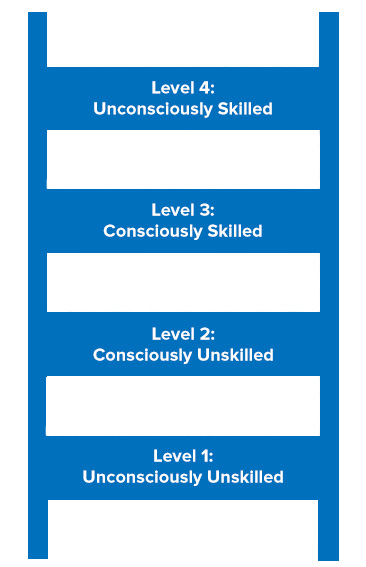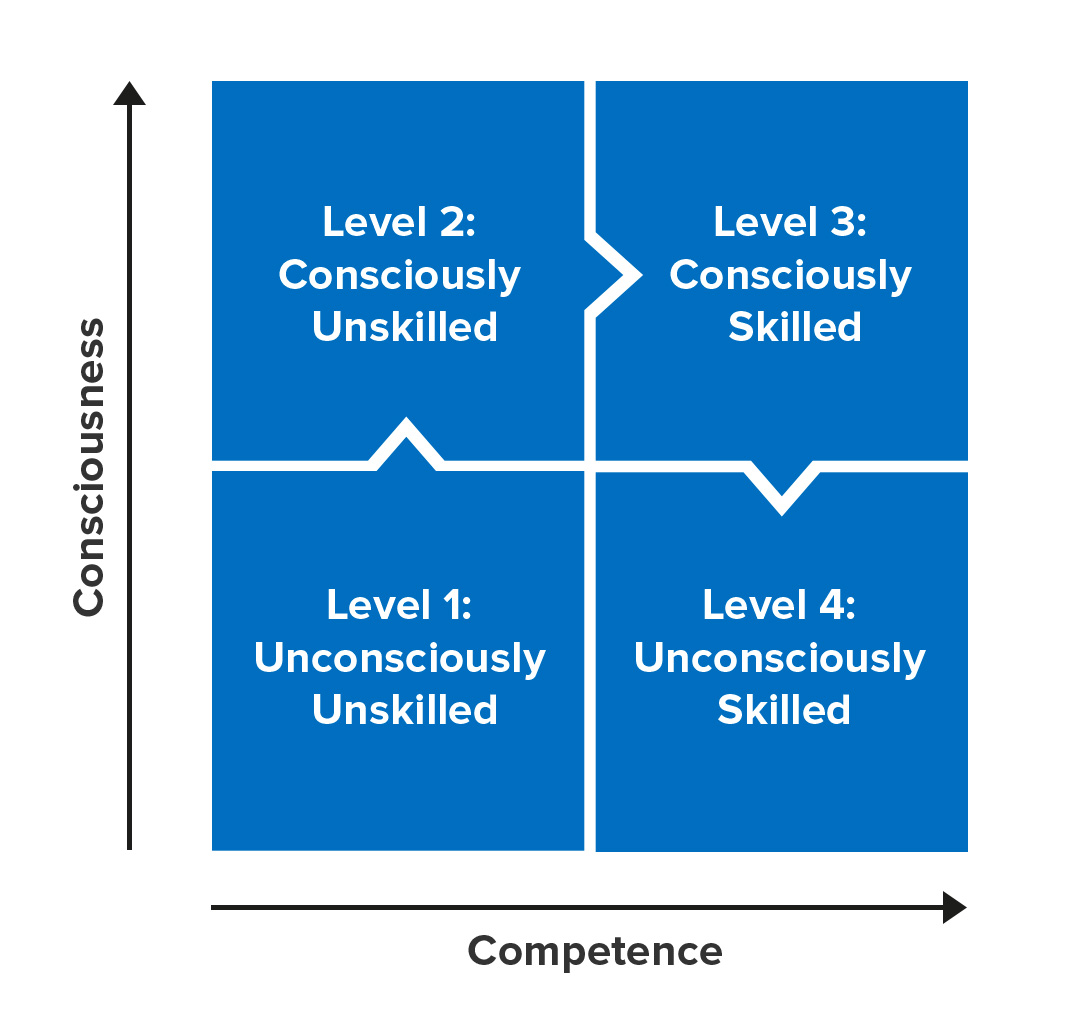The Conscious Competence Ladder
Developing Awareness of Your Skill Levels
Also called the Conscious Competence Matrix, the Learning Matrix, and the Four Stages of Learning

© GettyImages
stocknroll
Take the first steps on the "Ladder of Learning."
When we learn new skills, we experience different emotions at different stages of the learning process.
At the beginning, we may not realize how much we need to learn. Then, when we discover what we don't know about a subject, we may get disheartened, and we might even give up.
Recognizing how we feel at each stage of the learning process can help us to "stick with it" and manage these emotional ups and downs.
Understanding the Conscious Competence Ladder can help you to do this. In this article, reviewed and endorsed by the model's originators, we explore how you can use it to learn new skills more effectively.
What Is the Conscious Competence Ladder?
Noel Burch, an employee with Gordon Training International, developed the Conscious Competence Ladder in the 1970s.
The model highlights two factors that affect our thinking as we learn a new skill: consciousness (awareness) and skill level (competence).
According to the model, we move through the following levels as we build competence in a new skill:
- Unconsciously unskilled – we don't know that we don't have this skill, or that we need to learn it.
- Consciously unskilled – we know that we don't have this skill.
- Consciously skilled– we know that we have this skill.
- Unconsciously skilled – we don't know that we have this skill, but we don't focus on it because it's so easy.
This "ladder of learning" is shown in figure 1, below.
Figure 1 – The Conscious Competence Ladder

Reproduced with permission from Gordon Training International.
Some people prefer to think of the learning process as a matrix, with incompetence/competence on the horizontal axis and unconscious/conscious on the vertical axis (see figure 2, below). Use the representation that works best for you.
Figure 2 – The Conscious Competence Matrix

Reproduced with permission from Gordon Training International.
Why Is the Conscious Competence Ladder Useful?
The Conscious Competence Ladder is useful in several ways.
First, you can use it to understand the emotions you experience during the learning process. This helps you to stay motivated when you feel inadequate, or subject to self-doubt; and it helps you manage your expectations of success, so that you don't try to achieve too much, too soon.
For example, during the consciously unskilled phase, you can reassure yourself that, although learning this skill is difficult and frustrating right now, things will improve in the future. And, when you're unconsciously skilled, the model reminds you to value the skills that you've gained, and not to be too impatient with people who have yet to gain them.
It's also useful in coaching and training situations, because it allows you to be in touch with what your people are thinking and feeling. You can then help them to understand their emotions as they learn new skills, and encourage them when they're feeling disillusioned.
How to Use the Conscious Competence Ladder
The following sections look at each level in more detail, and highlight strategies that you can use to move yourself through each stage successfully, as you learn a new skill. They also cover strategies that you can use when you're guiding other people through the learning process.
Level 1 – Unconsciously Unskilled (You Don't Know That You Need This Skill)
The Dunning-Kruger Effect tells us that people with low competence find it hard to judge how unskilled they are. At this level, you are blissfully ignorant: you have a complete lack of knowledge and skills in a specific area, and you're unaware of this. Your confidence therefore far exceeds your abilities.
To move out of level 1, use tools like Personal SWOT Analysis and a Training Needs Assessment to identify your strengths and weaknesses, and to understand which skills you need to learn. As part of this, ask other people for their input, so that you can uncover weaknesses and skill needs that you might otherwise miss.
Also, make sure that you understand your learning objectives – there's no point learning skills in areas that don't align with your personal or work goals.
If you're coaching other people, be aware that at the beginning of the process, they may not know how unskilled they are. You'll need to make them understand how much they need to learn. You'll also need to explain why they need to learn these skills.
Be sensitive at this early stage, and give plenty of positive feedback to keep people's motivation high.
Level 2 – Consciously Unskilled (You Know That You Need This Skill)
By this stage, you've discovered that you need to learn new skills. You realize that others are much more competent than you are, and that they can easily do things that you are struggling with.
This level can be demoralizing, causing people to lose confidence or even give up on their learning efforts altogether. Therefore, it's important to stay positive at this stage.
Use tools like affirmations and Treasure Maps to combat negative thinking and to refocus your energy on days when you feel down. Remember, learning might be uncomfortable in the short term, but these skills will help you to reach your goals and build a better life.
When coaching others, provide plenty of encouragement and support during this stage, and explain the idea of the Conscious Competence Ladder, so that people understand any feelings of discouragement that they are experiencing. Also, help them to improve their self-confidence, if required.
Tip:
Consider keeping a diary to help you record and reflect on your thoughts, feelings and progress. You could also note any strategies that you use to reassure yourself, and to improve your skills.
Level 3 – Consciously Skilled (You Know That You Have This Skill)
At this level, you know that you have acquired the skills and knowledge you need. You put your learning into practice regularly, and you gain even more confidence as you use your new skills.
You still need to concentrate when you perform these activities, but, as you get more practice and experience, these activities become increasingly automatic.
To move successfully through Level 3, look for opportunities to use your skills as often as you can. For example, you could volunteer for projects that require your new skills, or craft your job to use these skills more often in your current role.
If you're coaching team members, keep them focused on the skills that they need to learn, and give them plenty of opportunities to practice these skills.
For example, you could assign them projects that use their new skills, or set them relevant training exercises.
Level 4 – Unconsciously Skilled (This Skill Is Now Effortless)
At this level, you use your new skills effortlessly. They have become "second nature." You can perform tasks and make important decisions without conscious effort. You are completely confident of success.
Once you master one set of skills, it's important to learn more if you want to continue to grow.
A good way to do this is to teach these new skills to others in your organization. This will keep information fresh in your mind, deepen your understanding of the material, and give you a rewarding way to pass this knowledge on to others.
Also, bear in mind that you may go back down the ladder if you don't use your new skills regularly.
If you're coaching, make sure that people avoid complacency, and that they stay up-to-date with their skills.
You may also need to remind people how difficult it was to reach this level, so that they offer empathy and support to people who are at an earlier stage in the process.
Even when your team members are unconsciously skilled, encourage them to use checklists and formal procedures so that they still need to think about what they're doing at important points.
Example:
Kezia's role in Marketing meant that she had to give regular presentations. However, her co-workers found her graphics confusing, her material disorganized, and her delivery disjointed. Kezia, however, didn't realize that there was anything wrong. She was unconsciously unskilled.
Her manager, Rowan, suggested that she take a learning course in presentation skills. After a couple of sessions, Kezia began to realize just how bad her presentations must have been. She had become consciously unskilled, and felt despondent. Rowan encouraged her to continue to develop her skills, and held informal meetings with her to boost her self-confidence.
Kezia's skills improved. She became consciously skilled, happier, and confident in her new-found ability to give effective presentations with integrated graphics and snappy delivery.
Finally Kezia became unconsciously skilled, and was able to give excellent presentations on a range of subjects at short notice. Rowan encouraged her to reflect on her new skills, and to pass them on to others.
Key Points
Noel Burch, an employee with Gordon Training International, developed the Conscious Competence Ladder in the 1970s.
You can use it to manage your emotions during a potentially challenging learning process.
The model has four learning levels:
- Unconsciously unskilled.
- Consciously unskilled.
- Consciously skilled.
- Unconsciously skilled.
The model can be a useful guide for your own learning, but you can also use it when you are coaching others, to guide them through the emotional ups and downs of acquiring new skills.
This site teaches you the skills you need for a happy and successful career; and this is just one of many tools and resources that you'll find here at Mind Tools. Subscribe to our free newsletter, or join the Mind Tools Club and really supercharge your career!






Thank you for the feedback. This is an interesting perception of what the Competence Ladder is trying to teach. For example, the skill to analyse is not necessarily something you thought about while reading through the article. Yet, you have applied your analytical skills in an unconscious manner to analyse the article.
Yes, it is - "it just seems easy," Is correct because the knowledge or skill is now a habit.
Well said.
As with any learning strategy for me, the Conscious Competence stage is the most challenging as nothing has moved into automatic drive yet (unconscious competence), and if I get it wrong I'll get stuck in the wrong gear wondering why I'm moving forward so slowly.
Bill
Mind Tools Team